► New Range Rover Sport
► Third generation
► Diesel, petrol and hybrid – pure EV in 2024
This is the third generation Range Rover Sport, Britain’s high-performance SUV. There’s been a big engineering focus on the Sport’s on-road dynamism, while still maintaining Land Rover’s trademark off-road capability. However, the 4×4 is at least 100kg heavier than the outgoing model, and runs petrol and diesel engines posting high fuel consumption and CO2 figures. Thankfully there are a choice of plug-in hybrid Range Rovers with 54-mile electric ranges, and a pure EV version coming in 2024.

Stiffer body, standard air suspension
‘The dynamic capability of this car is far beyond its predecessor’s,’ boasts executive director Nick Collins. It stems from solid foundations: the aluminium-intensive MLA Flex architecture, shared with the new Range Rover. The Sport’s body architecture is 35 per cent stiffer than before. ‘It literally has sports-car levels of stiffness,’ claims Collins.
And that provides a robust base for mounting the suspension – double wishbones up front, a five-link rear axle – equipped as standard with twin-valve monotube dampers and Land Rover’s first dual-chamber air springs. The system can switch to max pressure in milliseconds, tying down the body for corners or eliminating pitch under hard acceleration or braking. ‘It brings a real edge and attitude to its handling,’ grins Collins.
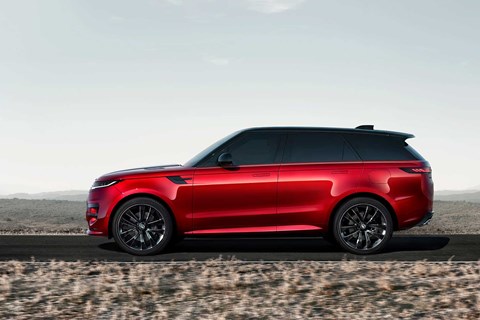
All-wheel drive and Terrain Response
The Range Rover Sport naturally has all-wheel drive, intelligently varying torque flow between the axles to boost traction, and decoupling the front axle on a steady cruise to save fuel.
And Land Rover’s familiar Terrain Response system is standard, with six settings to prime the Range Sport for its surroundings. It configures the air suspension, eight-speed automatic transmission, throttle and steering maps to tackle different conditions, ranging from snow to rocky off-road to the B660 in the enhanced Dynamic mode.
The on-road bias doesn’t compromise the Sport’s off-roading chops, Land Rover claims. Air springs offer a 135mm ride-height boost, and vertical wheel articulation spans half a metre. Terrain Response can prime the 4×4 for all surfaces, from 45˚ gradients to wading in 900mm of water.
Stormer handling pack
To get the most dynamic Range Rover Sport, customers will need to spec the £5330 Stormer handling pack. Named after the 2004 concept car which presaged the first-gen RRS, this adds Dynamic Response Pro anti-roll control. Electronically controlled motors that respond in milliseconds subject each axle to up 1033lb ft of torque, countering lateral roll.
Rear-wheel steering is also added, with up to 7.3˚ of swivel contrasting with the fronts at lower speeds to boost cornering, while both wheels turn in unison at higher speeds to boost stability. This reduces the turning circle by two metres to 11 metres.
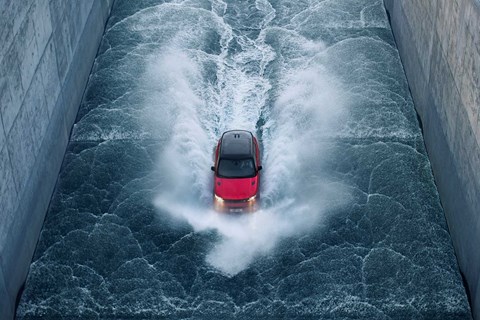
The pack includes torque vectoring by braking, nipping the disc on the inside rear wheel in corners, making the chassis pivot more sharply. And as you power out, an electronic active differential will shuffle torque across the rear axle, eliminating slip and boosting grip. The final Stormer benefit is Adaptive Dynamics, with Bilstein monotube dampers added to further lash down the body.
Plug-in hybrids and BMW V8
Two plug-in hybrids will be available, badged P440e and P510e, which combine a 3.0-litre straight-six petrol with a 105kW electric motor. The new hybrids have two more cylinders than the outgoing P400e, but Land Rover argues a four-pot wrung to the max is more polluting and less refined than using a less-stressed inline six. The base P440e makes 434bhp, while the punchier P510e makes 503bhp.
The battery pack has more than doubled in size to 38.2kWh, though this makes for colossal cars: the P440e weighs 2660kg and the P510e tops out at 2735kg – that’s 271 kilos heavier than the old P400e. The upside is that the PHEV should manage a real-world zero-emissions range of 54 miles, even on bitterly cold days. Indeed, Collins promises a 460-mile capability when you burn hydrocarbons too. The sizeable battery will take an hour to charge on a DC charger, or just under five hours on a 7.2kW wallbox.
The flagship petrol engine is a BMW-sourced 4.4-litre V8, breathed on by twin turbochargers to whip up 523bhp and 553lb ft of torque. That’s 20 per cent more twist action than JLR’s supercharged V8 could generate, and 17 per cent more efficient, which equates to 24mpg on the WLTP combined fuel consumption cycle. Using launch mode, this Range Rover Sport P530 can bludgeon its way from standstill to 62mph in 4.5sec.
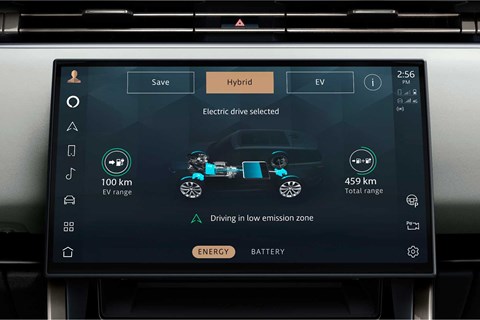
The engine line-up in full
Diesel
- D250 mHev: 246bhp, 442lb ft, from 34.9mpg and 194g/km CO2, 8.0secs 0-62mph, 128mph
- D300 mHev: 296bhp, 479lb ft, from 34.9mpg and 194g/km CO2, 6.6secs 0-62mph, 135mph
- D350 mHev: 345bhp, 516lb ft, from 35.3mpg and 195g/km CO2, 5.9secs 0-62mph, 145mph
Petrol
- P360 mHev: 355bhp, 369lb ft, from 28.2mpg and 212g/km CO2, 6.0secs 0-62mph, 140mph
- P400 mHev: 395bhp, 542lb ft, from 28.2mpg and 213g/km CO2, 5.7secs 0-62mph, 150mph
- P530: 523bhp, 553lb ft, from 24.1mpg and 254g/km CO2, 4.5secs 0-62mph, 155mph
Plug-in hybrid
- P440e: 434bhp, 413lb ft, from 313.9mpg and 18g/km CO2, 5.8secs 0-62mph, 140mph
- P510e: 503bhp, 413lb ft, from 313.9mpg and 18g/km CO2, 5.4secs 0-62mph, 150mph
Design and aerodynamics
The design is instantly recognisable as a Range Rover Sport, with its roofline sloping backwards and its trademark swage line arrowing forwards, lines that combine with the curved lower sill to inject dynamism into that hulking, 4946mm-long body. The surfaces are cleaner with a little more curve, and that immaculate finish where sideglass meets body panel instantly dates other cars with their clumsy black strips to guide the windows. It’s a detail ‘inspired by modern building architecture,’ observes exterior designer Dominic Najafi.

The proportions are further enhanced by a shorter front overhang, a 75mm longer wheelbase to increase rear legroom, a longer rear overhang and wheels stretching from standard 20-inchers to leviathan 23s. The grille is slimmer, to distinguish from the stately Range Rover’s approach, as are the headlamps.
The most striking angle is the rear, which strips away all embellishment for a true expression of creative director Gerry McGovern’s reductionist mantra. It’s graphically strong: visor-like screen, Botoxed lip above the registration plate, crisp C-shaped edges to trip off air, and rear lights with dazzling red OLED strips embedded inside. The wide, 835-litre loadbay is 55 litres bigger to the roof behind the three rear seats – there won’t be a seven-seat option this time.
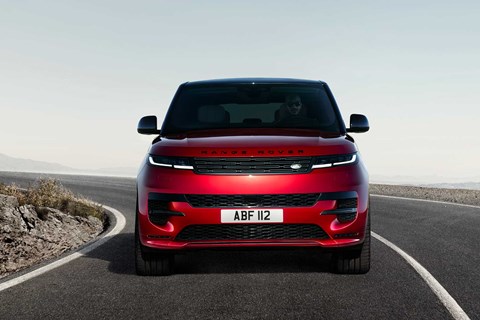
An extended rear spoiler and optimised underbody are also part of the aero package: the 0.29 drag coefficient is tidy for a hulking SUV. The Sport drops by 16mm at speed to improve airflow, and the cabin should be a peaceful place: microphones in the wheelarches feed the cockpit’s active noise cancellation system.
Range Rover Sport interior
The interior preserves the Sport’s snug cockpit, a deliberate contrast with the more upright and spacious Range Rover. A high centre console flows into a slanted and slightly curved 13.1-inch touchscreen, complemented by a 13.7-inch digital driver’s instrument panel. The steering wheel is smaller than the big Rangie’s and the driver sits 20mm lower. ‘Put it all together and you have a very different experience from the Range Rover, with a much more cockpit-like feel,’ says interior designer Thomas Holden.

And it employs some lovely, sustainable new materials. One option is the Ultrafabric luxury polyurethane upholstery, which is grained like leather (and priced at a similar premium) but has a dramatically different carbon footprint. ‘It’s fantastically tactile and grippy,’ says materials expert Kissia Siqueira. The floor mats are made from 78 per cent recycled plastic too.
Each stereo speaker is hidden behind a textile panel, a touch reminiscent of high-end audio systems. And many of the chrome accents have a dark satin finish, unless they’re to highlight key controls, in which case bright chrome is used.
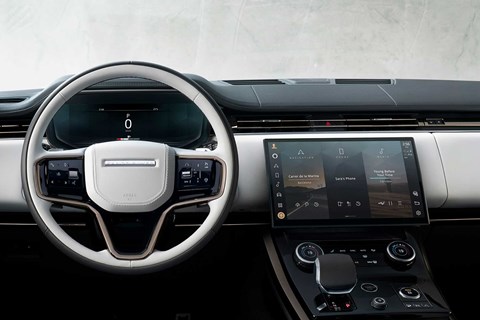
The headliner is finished in a contrasting colour to the pillars, mirroring Land Rover’s trademark ‘floating roof’ facilitated by black pillars. Dynamic-spec cars’ exteriors are finished in full body colour, the core model has plastic wheelarch protection, and Autobiography cars sport a black roof.
Smart tech and priced from £79k
There’s plenty of convenience tech to delight consumers. Smartphone connection is wireless, Amazon’s Alexa will take your voice commands, the essential 360˚ cameras have downlighters to make kerbside parking less fraught at night, and you can slide the car out of a parking space remotely by app if dimwits have parked too close.
Option the digital LEDs and they’ll manipulate 1.3m digital micromirrors to provide an incredible array of ever-changing light, fanning out vast rays while simultaneously blacking out areas for neighbouring traffic. It works impressively on Audi’s current A8.
Order books are now open for the new Range Rover Sport, with first deliveries arriving in August and costing from £79,125 – a £15k premium over the outgoing model. Let us know what you think in the comments below.